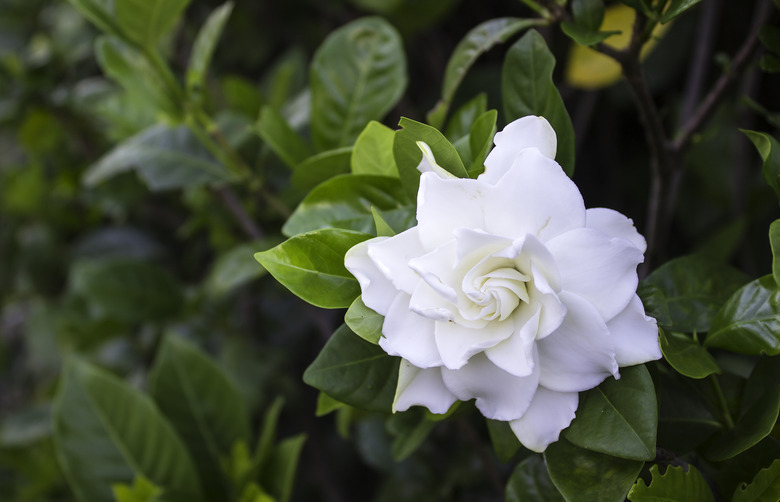How To Treat Black Mold Fungus On A Gardenia
Before choosing a treatment for black mold fungus on a gardenia (Gardenia jasminoides, USDA plant hardiness zones 7-11), it's important to understand the cause of the black leaves, which is sooty mold. The fungus can quickly turn the dark-green leaves on your beautifully blooming gardenias black. Sooty mold doesn't usually damage the plant since it only grows on the surface, but it's a sign that your gardenia has other issues.
What Causes Sooty Mold?
Sooty mold grows on the leaves of gardenia bushes that are infested with sap-sucking insects. Aphids, scales, mealybugs, whiteflies and other insects eat the sap from your gardenias. The sugar that the insects can't digest gets excreted onto the leaves as a sticky substance called honeydew.
Sooty mold fungus grows on the leaves using the honeydew as its nourishment. It only grows on the surface and doesn't affect the plant tissue directly. However, if the fungus grows over the leaves in a thick layer, it can block sunlight and interfere with photosynthesis. This can affect the gardenia's growth and even cause those affected leaves to die.
Reducing the number of insects feeding on the gardenia naturally helps to get rid of the fungus. With fewer insects, the amount of honeydew on the plants decreases. Since the fungus uses the honeydew as nourishment, it also decreases over time. Use natural methods to reduce the insect infestation to keep your garden safe.
Check for Active Insect Infestation
If you see sooty mold, there's a good chance you have a current insect infestation on your gardenia, but it's possible that the infestation is over. Inspect your plants carefully to see if you can spot insects on them. If so, you need to treat the insect infestation to eliminate the problem and get rid of the black sooty mold long term. If you don't see any insects at first glance, check the undersides of the leaves, which is where many of them like to hang out.
Spray Water on the Gardenias
If you have a minor insect problem, spraying the insects with water might get rid of them. Grab your garden hose and direct it where you see the insects. They often attack new plant growth, so check those areas first. Keep an eye on the plant to make sure the insects are gone and continue with regular care, including fertilizing and water, to help the plant stay strong to resist future infestations.
Prune Infested Sections
If the insects are only affecting a few parts of the plant, you can prune your gardenia to remove those areas. Use your garden pruners to cut off the infested branches. Remove the pruned branches from the area to avoid letting the insects infest the plant again.
Encourage Natural Predators
Natural predators help control the harmful pests that suck your gardenia's sap. Avoid using insecticides, which can kill those beneficial insects as well.
Ants can also be a problem for natural insect predators. Since ants also like the honeydew, they'll often protect the sap-sucking insects from those natural predators. Keeping ants under control near your gardenias can help the beneficial insects flourish so they can naturally take care of the problem insects.
Wipe Off Sooty Mold
Since the mold doesn't infect the inner tissue of the plant, it can be wiped off the leaves. Sometimes, a hose is enough to wash off the sooty mold. If the hose doesn't do the trick, you can use a wet cloth to wipe the black fungus off the leaves. Just wiping it off isn't enough to keep the sooty mold away, though. If the insects remain, the fungus will likely grow back.
